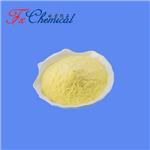- Hematoxylin
-

- $79.00/ kg
-
2025-04-25
- CAS:517-28-2
- Min. Order: 1kg
- Purity: 99%
- Supply Ability: 20ton
- Hematoxylin
-

- $0.00 / 1KG
-
2025-04-25
- CAS:517-28-2
- Min. Order: 1KG
- Purity: 98%min
- Supply Ability: 30tons/month
- Hematoxylin
-

- $6.00 / 1kg
-
2025-04-25
- CAS:517-28-2
- Min. Order: 1kg
- Purity: 99%
- Supply Ability: 2000KG/Month
|
| | Hematoxylin Basic information |
| | Hematoxylin Chemical Properties |
| Melting point | 200 °C (dec.)(lit.) | | Boiling point | 363.32°C (rough estimate) | | density | 1.2514 (rough estimate) | | bulk density | 500kg/m3 | | vapor pressure | 0-0Pa at 20-25℃ | | refractive index | 1.4600 (estimate) | | storage temp. | Keep in dark place,Inert atmosphere,Room temperature | | solubility | Soluble in 95% ethanol(1 mg/mL). | | form | Powder/Solid | | Colour Index | 75290 | | pka | 6.7(at 25℃) | | color | Yellow to Brown | | PH Range | Red (0.0) to yellow (1.0);Pale yellow (5.0) to violet (6.0) | | Water Solubility | SOLUBLE IN HOT WATER | | Sensitive | Light Sensitive | | λmax | 292nm, 445nm, 560nm | | Merck | 14,4637 | | BRN | 91399 | | Stability: | Stable, but may discolour on exposure to light. Incompatible with strong oxidizing agents. | | Major Application | Plasma displays, textiles, hair dyes, identifying fresh and stale rice, diag-nosing cancer progression, detecting nosing cancer progression, cervical disease, central nervous system malfunctions, detecting genes, breast cancer, collagen in a tissue sample, apoptosis, demyelinating diseases, antigens, treatment of age-related macular degeneration, burns, prostate cancer, diabetesand obesity, viral diseases, neoplasms, peripheral neural and vascular ailments, skin disorders, biotechnological applications, reference standard materials for cytology, histology andimmunohistochemistry | | InChIKey | WZUVPPKBWHMQCE-UHFFFAOYSA-N | | LogP | 0.3 at 30℃ and pH6.9 | | CAS DataBase Reference | 517-28-2 | | EPA Substance Registry System | Hematoxylin (517-28-2) |
| | Hematoxylin Usage And Synthesis |
| Chemical Properties | light brown crystals or powder | | Uses | Hematoxylin and eosin together make up Hematoxylin and eosin stain, one of the most commonly used stains in histology. Metal-haematein complexes are used to stain cell nuclei prior to examination under a microscope. Structures that stain with iron- or aluminum-haematein are often called basophilic, even though the mechanism of the staining is different from that of staining with basic dyes. | | Uses | Colorant in inks, biological stains. | | Definition | ChEBI: (+)-haematoxylin is a haematoxylin. It is an enantiomer of a (-)-haematoxylin. | | General Description | White to yellowish crystals that redden on exposure to light. | | Air & Water Reactions | Soluble in hot water, slightly water soluble in cold . | | Reactivity Profile | Sensitive to light. . | | Hazard | May be carcinogenic. | | Biological Activity | Hematoxylin is an organic stain which chelates with metal ions and binds to DNA and RNA. It is used for staining nucleus of the cells. Hematoxylin along with eosin stain is used in the diagnosis of invasion stage in tumors. | | storage | Store at RT | | Purification Methods | Hematoxylin recrystallises from H2O (as trihydrate) in white-yellow crystals which become red on exposure to light and then melt at 100-120o. It has been recrystallised from Me2CO/*C6H6. It has been recrystallised as well from dilute aqueous NaHSO3 until colourless and is soluble in alkali, borax and glycerol. Store it in the dark below 0o. [Morsingh & Robinson Tetrahedron 26 182 1970, Dann & Hofmann Chem Ber 98 1498 1955, Beilstein 17/8 V 469.] |
| | Hematoxylin Preparation Products And Raw materials |
|